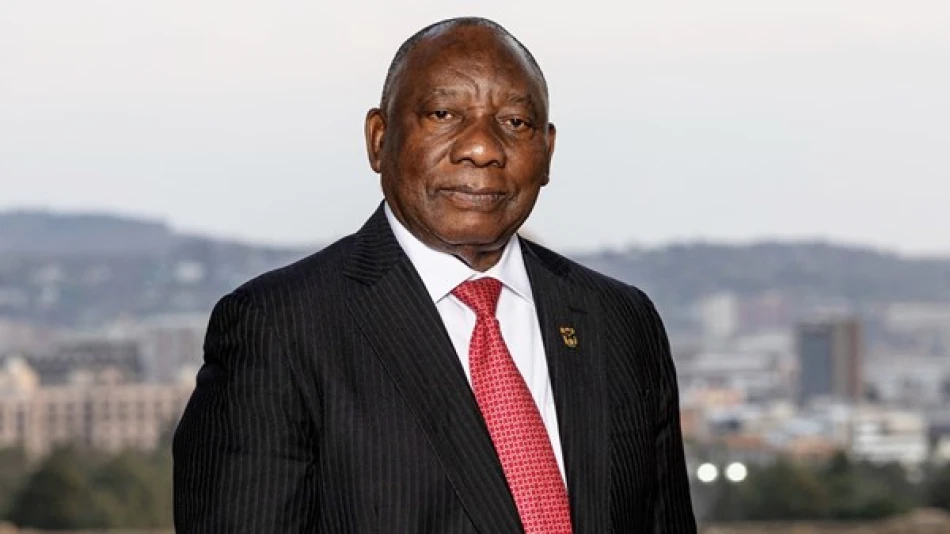
South Africa Seeks Alternative Markets to Tackle US Tariffs
South Africa Pivots to Africa-Asia Trade as 30% US Tariffs Threaten Economic Lifeline
South Africa is scrambling to diversify its export markets toward Africa and Asia as the country braces for devastating 30% US tariffs—the highest imposed on any sub-Saharan African nation. With 100,000 jobs at risk and economic growth already stagnating at just 0.1%, President Cyril Ramaphosa's pivot strategy represents a critical test of whether emerging economies can successfully decouple from traditional Western trade dependencies.
The Tariff Shock That Changes Everything
The 30% tariff rate hitting South Africa stands as an outlier even in an era of rising trade protectionism. President Cyril Ramaphosa called for "urgent and decisive action" as his government faces what Foreign Minister Ronald Lamola warned could slash economic growth by 0.2%—a devastating blow for a country that managed only 0.1% GDP growth in the first quarter.
The timing couldn't be worse. South Africa's unemployment rate already exceeds 30%, among the highest globally, and the loss of 100,000 jobs would push social tensions to breaking points that have historically triggered unrest.
Why This Tariff Rate Matters Globally
The 30% figure isn't arbitrary—it signals a fundamental shift in how the US views trade relationships with middle-income emerging markets. Unlike the blanket tariffs applied to China during previous trade wars, this targeted approach suggests Washington is willing to sacrifice strategic partnerships in pursuit of domestic economic priorities.
For investors, this creates a new risk category: countries that fall into the "too developed for preferential treatment, too small for special consideration" gap. South Africa's experience may preview similar actions against other emerging markets like Brazil, Mexico, or Turkey.
The Africa-Asia Pivot: Realistic Alternative or Desperate Gamble?
Ramaphosa's call to "accelerate diversification of our export markets" through enhanced intra-African trade sounds strategically sound, but faces harsh realities. The African Continental Free Trade Area (AfCFTA), while promising on paper, still lacks the infrastructure and financial systems to absorb South Africa's current export volumes.
Asian markets present better immediate prospects. China already serves as South Africa's largest trading partner, and countries like India and Vietnam have shown appetite for South African minerals and agricultural products. However, these relationships often involve commodity dependence rather than the value-added manufacturing that creates sustainable employment.
Learning from UAE and Singapore's Playbook
South Africa's situation mirrors challenges faced by the UAE and Singapore in previous decades—both successfully transformed from Western-dependent economies into global trade hubs by aggressively courting Asian partnerships. The key difference: those countries invested heavily in becoming service and logistics centers, not just commodity exporters.
Market Implications and Investment Outlook
Currency markets have already begun pricing in South Africa's trade disruption, with the rand showing increased volatility against major currencies. Mining companies—particularly those focused on precious metals and rare earth elements—face immediate pressure as US demand represents a significant portion of their revenue streams.
However, this crisis creates opportunities for infrastructure and logistics companies positioned to facilitate South-South trade. Ports, shipping lines, and financial services companies that can bridge African and Asian markets may see increased demand.
The Broader Precedent
South Africa's forced diversification represents more than bilateral trade friction—it signals the acceleration of a multipolar trading system. As traditional Western markets become less reliable partners, emerging economies are creating alternative networks that could fundamentally reshape global commerce.
The success or failure of South Africa's pivot will be closely watched by other middle-income countries wondering whether economic independence from Western markets is achievable or merely aspirational. With tariffs set to take effect this Friday, the experiment begins immediately.
 Layla Al Mansoori
Layla Al Mansoori







